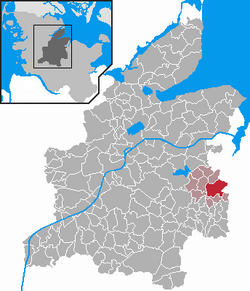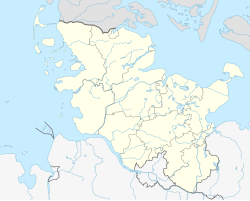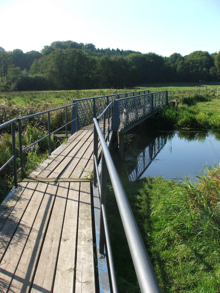world.wikisort.org - Germany
Flintbek is a municipality in the district of Rendsburg-Eckernförde, in Schleswig-Holstein, Germany. It is on the River Eider, c. 10 km southwest of Kiel. The meaning of the name is controversial but one possibility is the combination of flint(stone) with the word bek (beck, brook).
Flintbek | |
|---|---|
Municipality | |
 Flag  Coat of arms | |
Location of Flintbek within Rendsburg-Eckernförde district  | |
 Flintbek  Flintbek | |
| Coordinates: 54°15′N 10°4′E | |
| Country | Germany |
| State | Schleswig-Holstein |
| District | Rendsburg-Eckernförde |
| Municipal assoc. | Flintbek |
| Government | |
| • Mayor | Horst-Dieter Lorenzen |
| Area | |
| • Total | 17.57 km2 (6.78 sq mi) |
| Elevation | 50 m (160 ft) |
| Population (2020-12-31)[1] | |
| • Total | 7,240 |
| • Density | 410/km2 (1,100/sq mi) |
| Time zone | UTC+01:00 (CET) |
| • Summer (DST) | UTC+02:00 (CEST) |
| Postal codes | 24220 |
| Dialling codes | 04347 |
| Vehicle registration | RD |
| Website | www.flintbek.de |
Flintbek is the seat of the Amt ("collective municipality") Flintbek.
Possible early evidence of wheeled transport has been found in conserved track trails in Flintbek dated c. 3,600 BC.[2]
Places of interest
The Lutheran Church dates back to at least 1223, when Earl Albrecht of Orlamünde, Governor of the Danish King, authorised the Monastery of St Augustine to build a church in Flintbek.[3] The present building is late gothic and has an impressive wooden tower and steeple. The interior has a carved wooden altar (Schnitzaltar).
In the church cemetery is a 1952 sculpture by Friedrich Wilhelm Klose, Mutter des Ostens (Mother of the East). She represents the suffering and misfortunes of those driven from their homes because of war. The inscription reads:
„Ich will euch trösten, wie einen seine Mutter tröstet. Jes. 66,13. Wir gedenken unserer teuren Toten in der ostdeutschen Heimat.“
"I will comfort you as one whom his mother comforts. Isa. 66.13. We pray for our beloved dead in the East German homeland."[4]

Also in the cemetery is a memorial to the dead of both World Wars.
There are pleasant walks along the river Eider. The oldest iron bridge in Germany (1865) is in the Eider Valley, in the adjacent community of Techelsdorf.[5]


References
- "Statistikamt Nord – Bevölkerung der Gemeinden in Schleswig-Holstein 4. Quartal 2020 (XLS-file)". Statistisches Amt für Hamburg und Schleswig-Holstein (in German).
- Anthony, David A. (2007). The horse, the wheel, and language: how Bronze-Age riders from the Eurasian steppes shaped the modern world. Princeton, N.J: Princeton University Press. p. 66. ISBN 0-691-05887-3.
- "Kirchengemeinde Flinkbek". Unsere Kirche - Geschichte und Gegenwart. Retrieved 2015-11-22.
- "Gemeinde Flintbek: Leben und Wohnen - Gästeinformation - Mutter Osten". www.flintbek.de. Retrieved 2015-11-22.
- "Techelsdorf". memim.com. Retrieved 2015-11-22.
External links
На других языках
- [en] Flintbek
[ru] Флинтбек
Флинтбек (нем. Flintbek) — коммуна в Германии, в земле Шлезвиг-Гольштейн.Другой контент может иметь иную лицензию. Перед использованием материалов сайта WikiSort.org внимательно изучите правила лицензирования конкретных элементов наполнения сайта.
WikiSort.org - проект по пересортировке и дополнению контента Википедии